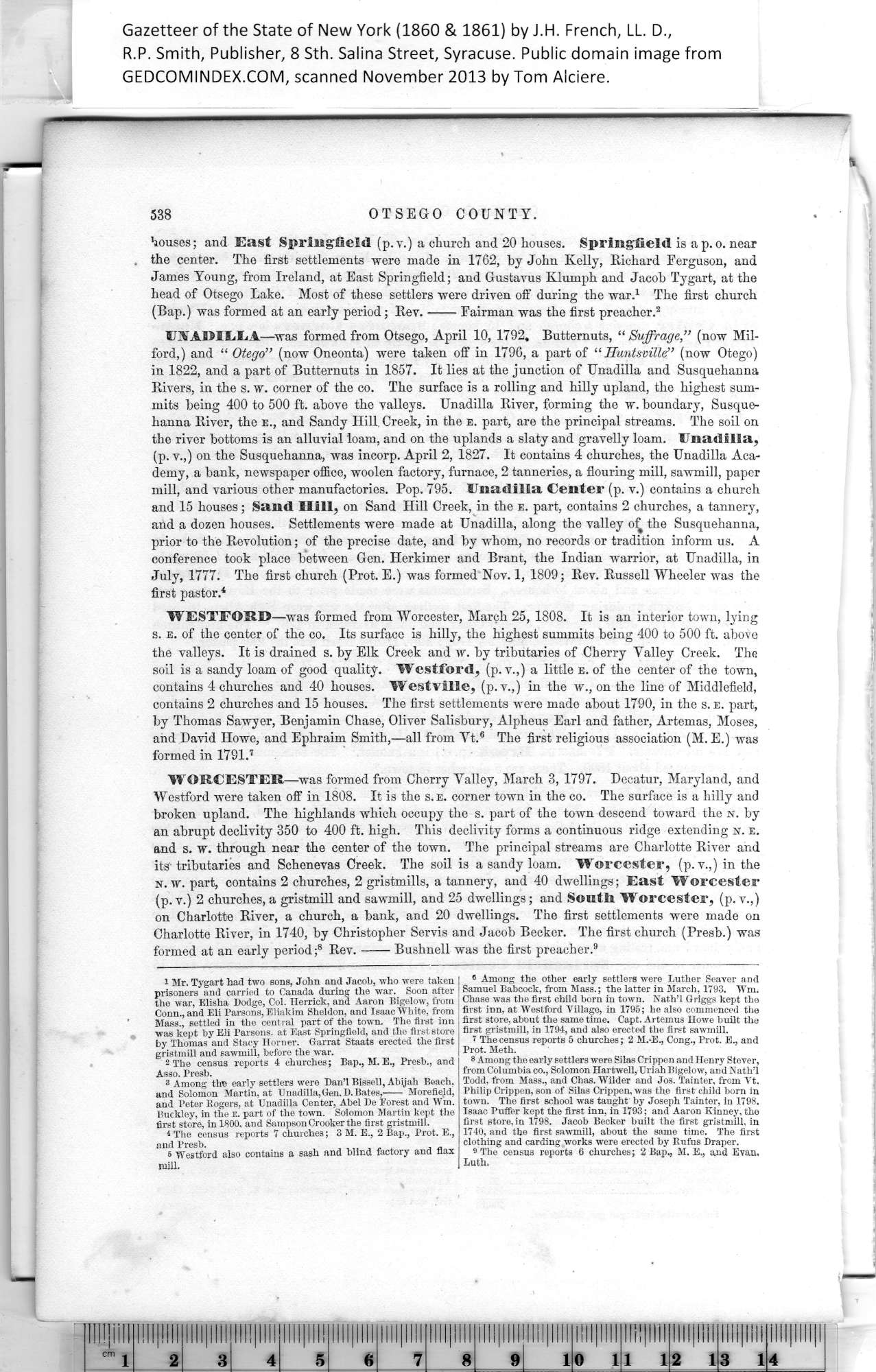|
OTSEGO COUNTY.
houses; and East Springfield (p.v.) a church and 20 houses. Springfield is a p.o. near
the center. The first settlements were made in 1762, by John Kelly, Richard Ferguson, and
James Young, from Ireland, at East Springfield; and Gustavus Klumph and Jacob Tygart, at the
head of Otsego Lake. Most of these settlers were driven ofl’ during the war.1 The first church
(Bap.) was formed at an early period; Rev. Fairman was the first preacher.2
UWAOIEEA—was formed from Otsego, April 10, 1792* Butternuts, “Suffrage,” (now Mil¬
ford,) and “ Otego” (now Oneonta) were taken off in 1796, a part of “Huntsville” (now Otego)
in 1822, and a part of Butternuts in 1857. It lies at the junction of Unadilla and Susquehanna
Rivers, in the s. w. corner of the co. The surface is a rolling and hilly upland, the highest sum¬
mits being 400 to 500 ft. above the valleys. Unadilla River, forming the w. boundary, Susque¬
hanna River, the e., and Sandy Hill, Creek, in the e. part, are the principal streams. The soil on
the river bottoms is an alluvial loam, and on the uplands a slaty and gravelly loam. Unadilla,
(p. v.,) on the Susquehanna, was incorp. April 2, 1827. It contains 4 churches, the Unadilla Aca¬
demy, a bank, newspaper office, woolen factory, furnace, 2 tanneries, a flouring mill, sawmill, paper
mill, and various other manufactories. Pop. 795. Unadilla Center (p. v.) contains a church
and 15 houses ; Sand Mill, on Sand Hill Creek, in the e. part, contains 2 churches, a tannery,
and a dozen houses. Settlements were made at Unadilla, along the valley of the Susquehanna,
prior to the Revolution; of the precise date, and by whom, no records or tradition inform us. A
conference took place between Gen. Herkimer and Brant, the Indian warrior, at Unadilla, in
July, 1777. The first church (Prot. E.) was formed Nov. 1, 1809; Rev. Russell Wheeler was the
first pastor.3
WESTFORD—was formed from Worcester, March 25, 1808. It is an interior town, lying
s. e. of the center of the co. Its surface is hilly, the highest summits being 400 to 500 ft. above
the valleys. It is drained s. by Elk Creek and w. by tributaries of Cherry Valley Creek. The
soil is a sandy loam of good quality. Westford, (p.v.,) a little e. of the center of the town,
contains 4 churches and 40 houses. West ville, (p.v.,) in the w., on the line of Middlefield,
contains 2 churches and 15 houses. The first settlements were made about 1790, in the s. e. part,
by Thomas Sawyer, Benjamin Chase, Oliver Salisbury, Alpheus Earl and father, Artemas, Moses,
and David Howe, and Ephraim Smith,—all from Vt.6 The first religious association (M. E.) was
formed in 1791.7
WORCESTER—was formed from Cherry Valley, March 3, 1797. Decatur, Maryland, and
Westford were taken off in 1808. It is the s.e. corner town in the co. The surface is a hilly and
broken upland. The highlands which occupy the s. part of the town descend toward the n. by
an abrupt declivity 350 to 400 ft. high. This declivity forms a continuous ridge extending n. e.
and s. w. through near the center of the town. The principal streams are Charlotte River and
its'tributaries and Schenevas Creek. The soil is a sandy loam. Worcester, (p.v.,) in the
n. w. part, contains 2 churches, 2 gristmills, a tannery, and 40 dwellings; East W©reester
(p.v.) 2 churches,a gristmill and sawmill, and 25 dwellings; and South Worcester, (p.v.,)
on Charlotte River, a church, a bank, and 20 dwellings. The first settlements were made on
Charlotte River, in 1740, by Christopher Servis and Jacob Becker. The first church (Presb.) was
formed at an early period;8 Rev. Bushnell was the first preacher.9
|
the other early settlers were Luther Seaver and
Samuel Babcock, from Mass.; the latter in March, 1793. Wm.
Chase was the first child born in town. Nath’l Griggs kept the
first inn, at Westford Village, in 1795; he also commenced the
first store, about the same time. Capt. Artemus Howe built the
first gristmill, in 1794, and also erected the first sawmill.
7 The census reports 5 churches; 2 M.-E., Cong., Prot. E., and
Prot. Meth.
8 Among the early settlers were Silas Crippen and Henry Stever,
from Columbia co., Solomon Hartwell, Uriah Bigelow, and Nath’l
Todd, from Mass., and Chas. Wilder and Jos. Tainter, from Vt.
Philip Crippen, son of Silas Crippen, was th.e first child born in
town. The first school was taught by Joseph Tainter, in 1798.
Isaac Puffer kept the first inn, in 1793; and Aaron Kinney, the
first store, in 1798. Jacob Becker built the first gristmill, in
1740, and the first sawmill, about the same time. The first
clothing and carding works were erected by Kufus Draper.
9 The census reports 6 churches; 2 Bap,, M, E,, and Evan.
Luth. |
1
Mr. Tygart had two sons, John and Jacob, who were taken
prisoners and carried to Canada during the war. Soon after
the war, Elisha Dodge, Col. Herrick, and Aaron Bigelow, from
Conn., and Eli Barsons, Eliakim Sheldon, and Isaac White, from
Mass., settled in the central part of the town. The first inn
was kept by Eli Parsons, at East Springfield, and tbe first store
by Thomas and Stacy Horner. Garrat Staats erected the first
gristmill and sawmill, before the war.
2
The census reports 4 churches; Bap., M.E., Presb., and
Asso. Presb.
3
The census reports 7 churches; 3 M. E., 2 Bap., Prot. E.,
|
